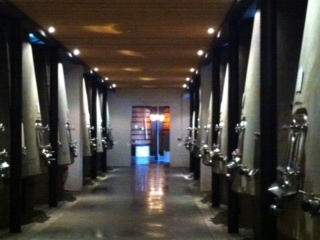In the past the main question was what should a wine vat be made of; wood, cement or stainless steel? And what is the optimal size? Today the wine vat subject has got more complicated, what shape should it take is the key question today? And it is causing lots of Grand Cru Classé headaches around the region. Producers from the smaller châteaux are more philosophical, as Yves Raymond of Listrac’s excellent Cru Bourgeois Saransot Dupré says ‘at some point the fashion comes back to what you have! ‘ His cement vats date from the 1930s and today are all of the rage.
Here are a few of the vats I have come accross in the past few weeks in the Medoc and St Emilion. Apparently the truncated stainless steel vats perform an excellent maceration of the Merlot grape at Château Beausejour Bécot.There is more contact of the Merlot juice onto the cap of skins so more is extracted from them!

Whereas at Pontet Canet in Pauillac where Cabernet is king, it is the conical cement vat that does the best job. There is less contact with the cap of skins so perhaps encourages a more gentle extraction of the thick-skinned Cabernets!?

They also have introduced amphoras to reduce the oak focus in their wines (since 2012 vintage) for ageing alone (not vinifying as the oak vats behind it is for)

I have heard that Cheval Blanc’s cuves are suspended (but what shape are they?…..I will fill you in on the explanation (there is bound to be a good one) when I visit at the end of June.

